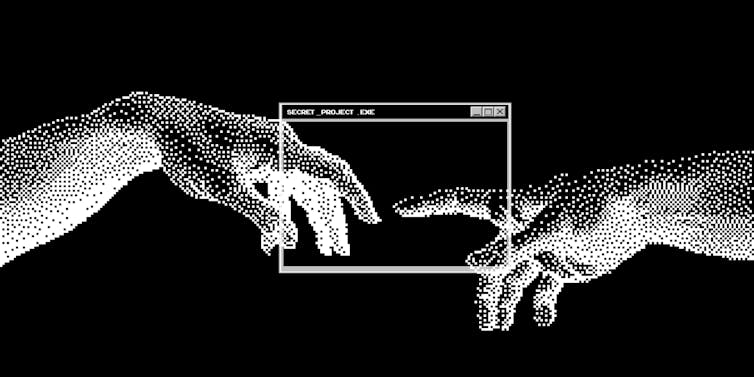Inside the 2016 science fiction movie Arrival, a linguist is confronted with the daunting means of deciphering an alien language consisting of palindromic phrases, which be taught the similar backwards as they do forwards, written with spherical symbols. As she discovers various clues, completely totally different nations all around the world interpret the messages in one other means – with some assuming they convey a menace.
If humanity ended up in such a situation proper now, our best guess may be to indicate to evaluation uncovering how artificial intelligence (AI) develops languages.
Nonetheless what exactly defines a language? Most of us use a minimal of 1 to talk with people spherical us, nevertheless how did it come about? Linguists have been pondering this very question for a few yearshowever there is not a easy method to learn the way language superior.
Language is ephemeral, it leaves no examinable trace inside the fossil knowledge. In distinction to bones, we’re in a position to’t dig up historic languages to test how they developed over time.
Whereas we may be unable to test the true evolution of human language, perhaps a simulation might current some insights. That’s the place AI is offered in – a fascinating space of research known as emergent communicationwhich I’ve spent the ultimate three years studying.
To simulate how language would possibly evolve, we give brokers (AIs) simple duties that require communication, like a recreation the place one robotic ought to data one different to a specific location on a grid with out displaying it a map. We provide (nearly) no restrictions on what they are going to say or how – we merely give them the obligation and permit them to clear up it nonetheless they want.
On account of fixing these duties requires the brokers to talk with each other, we’re in a position to analysis how their communication evolves over time to get an considered how language might evolve.
Comparable experiments have been completed with folks. Take into consideration you, an English speaker, are paired with a non-English speaker. Your course of is to instruct your confederate to decide on up a inexperienced cube from an assortment of objects on a desk.
You could try to gesture a cube type collectively together with your fingers and stage at grass exterior the window to level the colour inexperienced. Over time you’d develop a kind of proto-language collectively. Probably you’d create explicit gestures or symbols for “cube” and “inexperienced”. By means of repeated interactions, these improvised alerts would flip into additional refined and fixed, forming a major communication system.
This works equally for AI. By means of trial and error, they examine to talk about objects they see, and their dialog companions examine to know them.
Nonetheless how do everyone knows what they’re talking about? Within the occasion that they solely develop this language with their artificial dialog confederate and by no means with us, how do everyone knows what each phrase means? Finally, a specific phrase might indicate “inexperienced”, “cube”, or worse – every. This drawback of interpretation is a key part of my evaluation.
Cracking the code
The obligation of understanding AI language may appear nearly unimaginable at first. If I tried speaking Polish (my mother tongue) to a collaborator who solely speaks English, we couldn’t understand each other and even know the place each phrase begins and ends.
The issue with AI languages is even bigger, as they might organise data in strategies totally worldwide to human linguistic patterns.
Fortunately, linguists have developed delicate devices using data idea to interpret unknown languages.
Merely as archaeologists piece collectively historic languages from fragments, we use patterns in AI conversations to know their linguistic development. Sometimes we uncover stunning similarities to human languages, and totally different situations we uncover totally novel strategies of communication.

cybermagician/Shutterestock
These devices help us peek into the “black subject” of AI communication, revealing how artificial brokers develop their very personal distinctive strategies of sharing data.
My newest work focuses on using what the brokers see and say to interpret their language. Take into consideration having a transcript of a dialog in a language unknown to you, along with what each speaker was looking at. We are going to match patterns inside the transcript to issues inside the participant’s visible view, developing statistical connections between phrases and objects.
For example, perhaps the phrase “yayo” coincides with a hen flying earlier – we might guess that “yayo” is the speaker’s phrase for “hen”. By means of cautious analysis of these patterns, we’re in a position to begin to decode the which means behind the communication.
In the newest paper by me and my colleagues, to look inside the conference proceedings of Neural Information Processing Strategies (NeurIPS), we current that such methods might be utilized to reverse-engineer a minimal of elements of the AIs’ language and syntax, giving us insights into how they might development communication.
Aliens and autonomous packages
How does this hook up with aliens? The methods we’re creating for understanding AI languages might help us decipher any future alien communications.
If we’re ready to amass some written alien textual content material together with some context (comparable to seen data concerning the textual content material), we might apply the similar statistical devices to analyse them. The approaches we’re creating proper now might very nicely be useful devices ultimately analysis of alien languages, known as xenolinguistics.
Nonetheless we don’t need to get your hands on extraterrestrials to be taught from this evaluation. There are fairly a couple of functionsfrom bettering language fashions like ChatGPT or Claude to bettering communication between autonomous autos or drones.
By decoding emergent languages, we’re in a position to make future experience less complicated to know. Whether or not or not it’s determining how self-driving automobiles coordinate their actions or how AI packages make picks, we’re not merely creating intelligent packages – we’re finding out to know them.
